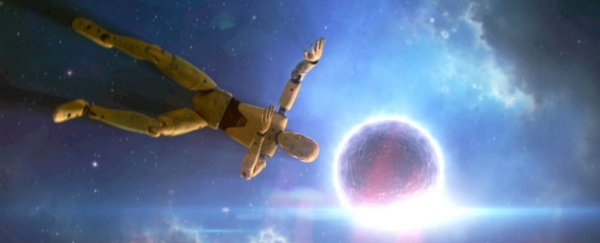Along with black holes, neutron stars are the densest objects known to science, and they're surrounded by a gravitational field so intense, they actually bend light around themselves, giving off a strange, shimmery effect.
But as enticing as that sounds, you don't want to get anywhere near a neutron star, because as the Science Channel video explains below, that gravitational force will start pulling you at speeds of around two-thirds the speed of light.
To give you an idea of how uncomfortable that would be, if you were travelling at the speed of light, you could circumnavigate Earth approximately 7.5 times in a single second.
Neutron stars are the crushed cores of massive stars that collapsed under their own weight when they ran out of fuel, and exploded as supernovae.
They're made of some of the densest material in the Universe - just 1 teaspoon of the stuff would weigh 1 billion tonnes on Earth - and their crust is 10 billion times stronger than steel.
The magnetic field of a neutron star is so intense, scientists have predicted the most powerful ones in our Universe can create a quantum disturbance in empty space, where matter spontaneously pops in and out of existence.
Similar to how scientists imagine a fatal interaction with a black hole would play out, the laws of physics predict that anything that wanders too close to a neutron star will be 'spaghettified' - gently stretched from limb to limb by gravitational forces 200 billion times stronger than on Earth.
But as Moogega Cooper, a planetary protection engineer at NASA, says in the video below, the so-called noodle effect is a fairly misleading description of the horror that would ensue if you somehow stumbled upon a neutron star.
"As you get closer and closer to a neutron star, we were told to think that it would be this elegant spaghettification where you could get longer and longer like a piece of spaghetti," says Cooper.
"But in reality, you'd kinda get ripped to shreds."
Once you've been reduced to nothing but a thin stream of atoms, the neutron star continues to bring the pain, because as those atoms hit the surface of the spinning core, it triggers a colossal burst of energy.
"He's gonna hit so hard, the amount of energy released is just huge, it would completely dwarf the entire arsenal of nuclear weapons on our planet," says astronomer Phil Plait.
To find out what the true meaning of overkill actually looks like, check out the Science Channel video below, and spare a thought for Chuck the crash test dummy, who I bet wishes he could be gently spaghettified instead:

